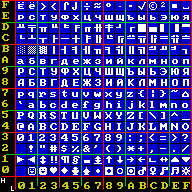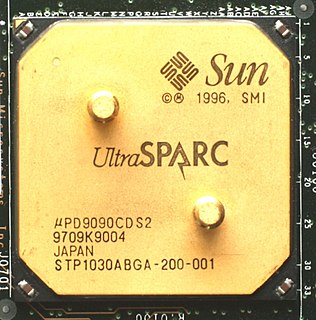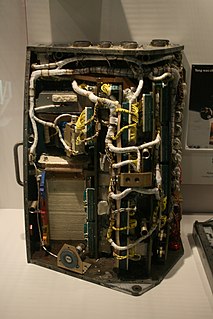Related Research Articles
The byte is a unit of digital information that most commonly consists of eight bits. Historically, the byte was the number of bits used to encode a single character of text in a computer and for this reason it is the smallest addressable unit of memory in many computer architectures. To disambiguate arbitrarily sized bytes from the common 8-bit definition, network protocol documents such as The Internet Protocol refer to an 8-bit byte as an octet. Those bits in an octet are usually counted with numbering from 0 to 7 or 7 to 0 depending on the bit endianness. The first bit is number 0, making the eighth bit number 7.

In computing, a nibble (occasionally nybble or nyble to match the spelling of byte) is a four-bit aggregation, or half an octet. It is also known as half-byte or tetrade. In a networking or telecommunication context, the nibble is often called a semi-octet, quadbit, or quartet. A nibble has sixteen (24) possible values. A nibble can be represented by a single hexadecimal digit (0–F) and called a hex digit.
The octal numeral system, or oct for short, is the base-8 number system, and uses the digits 0 to 7, that is to say 10octal represents eight and 100octal represents sixty-four. However, English, like most languages, uses a base-10 number system, hence a true octal system might use different vocabulary.

In computer engineering, a reduced instruction set computer (RISC) is a computer designed to simplify the individual instructions given to the computer in order to realise a task. Unlike the instructions given to a complex instruction set computer (CISC), with a RISC computer, a task might require more instructions (code) in order to realise a task, because the individual instructions are written in simpler code. The goal is to offset the need to process more instructions by increasing the speed of each instruction, in particular, implementing an instruction pipeline may be simpler given simpler instructions.

The Apollo Guidance Computer (AGC) is a digital computer produced for the Apollo program that was installed on board each Apollo command module (CM) and Apollo Lunar Module (LM). The AGC provided computation and electronic interfaces for guidance, navigation, and control of the spacecraft.
In computing, an opcode is the portion of a machine language instruction that specifies the operation to be performed. Beside the opcode itself, most instructions also specify the data they will process, in the form of operands. In addition to opcodes used in the instruction set architectures of various CPUs, which are hardware devices, they can also be used in abstract computing machines as part of their byte code specifications.
CRAM, or Card Random-Access Memory, model 353-1, was a data storage device invented by NCR, which first appeared on their model NCR-315 mainframe computer in 1962. It was also available for NCR's third generation NCR Century series as the NCR/653-100.
KDF9 was an early British computer designed and built by English Electric. The first machine came into service in 1964 and the last of 29 machines was decommissioned in 1980 at the National Physical Laboratory. The KDF9 was designed for, and used almost entirely in, the mathematical and scientific processing fields – in 1967, nine were in use in UK universities and technical colleges. The KDF8, developed in parallel, was aimed at commercial processing workloads.
In computer architecture, 48-bit integers can represent 281,474,976,710,656 (248 or 2.814749767×1014) discrete values. This allows an unsigned binary integer range of 0 through 281,474,976,710,655 (248 − 1) or a signed two's complement range of -140,737,488,355,328 (-247) through 140,737,488,355,327 (247 − 1). A 48-bit memory address can directly address every byte of 256 terabytes of storage. 48-bit can refer to any other data unit that consumes 48 bits (6 octets) in width. Examples include 48-bit CPU and ALU architectures are those that are based on registers, address buses, or data buses of that size.
The octet is a unit of digital information in computing and telecommunications that consists of eight bits. The term is often used when the term byte might be ambiguous, as the byte has historically been used for storage units of a variety of sizes.

The Launch Vehicle Digital Computer (LVDC) was a computer that provided the autopilot for the Saturn V rocket from launch to Earth orbit insertion. Designed and manufactured by IBM's Electronics Systems Center in Owego, New York, it was one of the major components of the Instrument Unit, fitted to the S-IVB stage of the Saturn V and Saturn IB rockets. The LVDC also supported pre- and post-launch checkout of the Saturn hardware. It was used in conjunction with the Launch Vehicle Data Adaptor (LVDA) which performed signal conditioning from the sensor inputs to the computer from the launch vehicle.

The NCR 315 Data Processing System, released in January 1962 by NCR, is a second-generation computer. All printed circuit boards use resistor–transistor logic (RTL) to create the various logic elements. It uses 12-bit slab memory structure using magnetic-core memory. The instructions can use a memory slab as either two 6-bit alphanumeric characters or as three 4-bit BCD digits. Basic memory is 5000 "slabs" of handmade core memory, which is expandable to a maximum of 40,000 slabs in four refrigerator-size cabinets. The main processor includes three cabinets and a console section that houses the power supply, keyboard, output writer, and a panel with lights that indicate the current status of the program counter, registers, arithmetic accumulator, and system errors. Input/Output is by direct parallel connections to each type of peripheral through a two-cable bundle with 1-inch-thick cables. Some devices like magnetic tape and the CRAM are daisy-chained to allow multiple drives to be connected.

The history of general-purpose CPUs is a continuation of the earlier history of computing hardware.
In computer architecture, 12-bit integers, memory addresses, or other data units are those that are 12 bits wide. Also, 12-bit central processing unit (CPU) and arithmetic logic unit (ALU) architectures are those that are based on registers, address buses, or data buses of that size.
In computing and telecommunications, a unit of information is the capacity of some standard data storage system or communication channel, used to measure the capacities of other systems and channels. In information theory, units of information are also used to measure information contained in messages and the entropy of random variables.
An instruction set architecture (ISA) is an abstract model of a computer, also referred to as computer architecture. A realization of an ISA is called an implementation. An ISA permits multiple implementations that may vary in performance, physical size, and monetary cost ; because the ISA serves as the interface between software and hardware. Software that has been written for an ISA can run on different implementations of the same ISA. This has enabled binary compatibility between different generations of computers to be easily achieved, and the development of computer families. Both of these developments have helped to lower the cost of computers and to increase their applicability. For these reasons, the ISA is one of the most important abstractions in computing today.
The following outline is provided as an overview of and topical guide to computing:
GEORGE is a programming language invented by Charles Leonard Hamblin in 1957.

The Gemini Guidance Computer was a digital, serial computer designed for Project Gemini, America's second human spaceflight project. The computer, which facilitated the control of mission maneuvers, was designed by the IBM Federal Systems Division.
Syllabic octal and split octal are two similar notations for 8-bit and 16-bit octal numbers, respectively, used in some historical contexts.
References
- ↑ Jones, Douglas W. (2016) [2012]. "A Minimal CISC". Computer Architecture On-Line Collection. Iowa City, USA: The University of Iowa, Department of Computer Science. Archived from the original on 2016-05-28. Retrieved 2016-05-28.
- ↑ Jones, Douglas W. (June 1988). "A Minimal CISC". ACM SIGARCH Computer Architecture News. New York, USA: Association for Computing Machinery (ACM). 16 (3): 56–63. doi:10.1145/48675.48684. S2CID 17280173.
- ↑ Beard, Bob (Autumn 1997) [1996-10-01]. "The KDF9 Computer — 30 Years On" (PDF). Resurrection - The Bulletin of the Computer Conservation Society. No. 18. Computer Conservation Society (CCS). pp. 7–15 [9, 11]. ISSN 0958-7403. Archived (PDF) from the original on 2020-07-27. Retrieved 2020-07-27. (NB. This is an edited version of a talk given to North West Group of the Society at the Museum of Science and Industry, Manchester, UK on 1996-10-01. It mentions the term "slob" and "slob-octal" as equivalent to "syllabic octal".)
- ↑ "Architecture of the English Electric KDF9 computer" (PDF). Version 1. Computer Conservation Society (CCS). September 2009. CCS-N4X2. Archived (PDF) from the original on 2020-07-27. Retrieved 2020-07-27. (NB. Refers to Beard's 1997 article.)
- ↑ English Electric KDF9: Very high speed data processing system for Commerce, Industry, Science (PDF) (Product flyer). English Electric. c. 1961. Publication No. DP/103. 096320WP/RP0961. Archived (PDF) from the original on 2020-07-27. Retrieved 2020-07-27.
- 1 2 Schneider, Carl (2013) [1970]. Datenverarbeitungs-Lexikon [Lexicon of information technology] (in German) (softcover reprint of hardcover 1st ed.). Wiesbaden, Germany: Springer Fachmedien Wiesbaden GmbH / Betriebswirtschaftlicher Verlag Dr. Th. Gabler GmbH. pp. 201, 308. doi:10.1007/978-3-663-13618-7. ISBN 978-3-409-31831-0. ISBN 3-663-13618-3 / ISBN 978-3-663-13618-7 (ebook). Retrieved 2016-05-24. pp. 201, 308:
slab, Abk. aus syllable = Silbe, die kleinste adressierbare Informationseinheit für 12 bit zur Übertragung von zwei Alphazeichen oder drei numerischen Zeichen. (NCR) […] Hardware: Datenstruktur: NCR 315-100 / NCR 315-RMC; Wortlänge: Silbe; Bits: 12; Bytes: –; Dezimalziffern: 3; Zeichen: 2; Gleitkommadarstellung: fest verdrahtet; Mantisse: 4 Silben; Exponent: 1 Silbe (11 Stellen + 1 Vorzeichen)
[ slab , abbr. for syllable = syllable, smallest addressable information unit for 12 bits for the transfer of two alphabetical characters or three numerical characters. (NCR) […] Hardware: Data structure: NCR 315-100 / NCR 315-RMC; Word length: Syllable; Bits: 12; Bytes: –; Decimal digits: 3; Characters: 2; Floating point format: hard-wired; Significand: 4 syllables; Exponent: 1 syllable (11 digits + 1 prefix)] - ↑ "315 Electronic Data Processing System" (PDF). NCR. November 1965. NCR MPN ST-5008-15. Archived (PDF) from the original on 2016-05-24. Retrieved 2015-01-28.
- ↑ Bardin, Hillel (1963). "NCR 315 Seminar" (PDF). Computer Usage Communique. 2 (3). Archived (PDF) from the original on 2016-05-24.
- ↑ Burkey, Ronald (2009-08-21). "Virtual AGC — AGS — LVDC — Gemini: Launch Vehicle Digital Computer (LVDC): Saturn IB and Saturn V Rockets". Archived from the original on 2016-05-28. Retrieved 2016-05-28.
- ↑ Burkey, Ronald (2010-09-06) [2011]. "Gemini Spacecraft Computer (OBC): Layout of Memory Words". Archived from the original on 2016-05-28. Retrieved 2016-05-28.